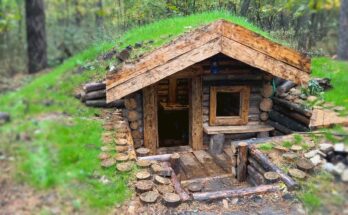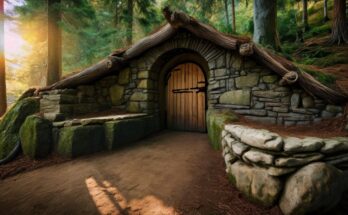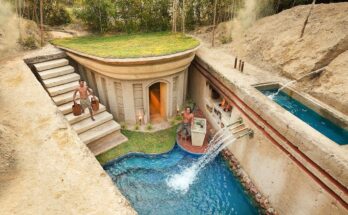Introduction
In the realm of sustainable living and eco-friendly architecture, constructing underground huts serves as both a practical solution for habitation and an intriguing blend of functionality and aesthetics. The image depicts a unique underground structure adorned with a grass roof and designed to include a fireplace and kitchen area, showcasing a harmonious relationship between human habitation and nature. This essay will explore the concept of underground huts, the necessary tools for construction, and the various benefits and challenges associated with building such structures.
Concept of Underground Huts
Underground huts, often referred to as earth-sheltered homes or dugouts, have been part of human habitation for thousands of years. They are built into the earth and provide unique advantages such as thermal stability, energy efficiency, and minimal impact on the environment. The grass roof serves both an aesthetic purpose and a functional one, as it aids in insulation, promotes biodiversity, and can be integrated into the surrounding landscape.
Design Features
-
Grass Roof:
- The grass roof not only blends the structure into its surroundings but also adds an extra layer of insulation, keeping the interior warm in winter and cool in summer.
- It allows rainwater absorption and provides a habitat for various plant and animal species.
-
Fireplace:
- A central fireplace provides a source of heat, cooking, and comfort, making the space more livable.
- Proper ventilation is crucial for safety, preventing smoke accumulation within the structure.
-
Kitchen Area:
- The kitchen, often constructed with clay and natural materials, promotes sustainability and creativity in using local resources.
- It includes essential features such as a sink, cooking space, and storage, all while maintaining an eco-friendly approach.
Tools for Construction
Constructing an underground hut requires a variety of tools and materials to ensure a successful build. Here’s a detailed list of essential tools:
-
Excavation Tools:
- Shovels: For digging the foundation and shaping the floor.
- Pickaxe: Useful for breaking harder ground or rocky soil.
- Mattock: A combination tool for digging and chopping roots.
-
Framework Tools:
- Saw: For cutting wooden beams for support structures.
- Measuring Tape: Essential for obtaining accurate measurements.
- Level: Ensures that the structure is built evenly and correctly.
-
Building Materials:
- Clay: For building walls, making it compatible with insulation needs and aesthetics.
- Wood: For structural support, roofing, and creating frameworks. Use treated wood to resist moisture.
- Grass/Sod: For creating the roof, promoting insulation and blending in with the environment.
-
Finishing Tools:
- Trowel: For applying clay or mud plaster to walls.
- Bucket: For transporting water and other materials.
- Hammer: For driving nails and fixing wooden components together.
-
Safety Gear:
- Gloves: Protects hands while working with rough materials.
- Goggles: Shields eyes from dirt and debris.
- Dust Mask: Useful when working with materials that produce dust or harmful particulates.
Construction Steps
-
Site Selection and Preparation:
- Choose a location that is not prone to flooding and has stable soil. Clear the area of any vegetation and debris.
-
Excavation:
- Dig a pit of suitable dimensions, accounting for walls, living space, and a chimney for the fireplace.
-
Building the Walls:
- Use clay mixed with straw for insulation and sturdiness. The walls should be at least a foot thick for optimal thermal performance.
-
Roof Construction:
- Build a wooden structure for support, then layer it with sod, allowing water drainage and plant growth.
-
Installing the Fireplace and Kitchen:
- Ensure the fireplace is placed where it can ventilate smoke properly. Build a kitchen area close to the fireplace for convenience.
-
Finishing Touches:
- Plaster the exterior walls with clay to protect from moisture. Add wooden shelves in the kitchen and create windows using natural materials.
Benefits of Underground Living
-
Energy Efficiency:
- Earth-sheltered homes have a lower energy footprint. Natural insulation helps maintain temperature, reducing heating and cooling costs.
-
Reduced Environmental Impact:
- Utilizing natural materials and sustainable practices significantly minimizes ecological disruption.
-
Natural Disaster Resilience:
- Underground huts offer safety from extreme weather, including heavy winds and floods. Their design can protect against fire and provide safety from wildlife.
-
Privacy and Noise Reduction:
- Being underground provides privacy and minimizes exposure to external noise, creating a serene environment.
Challenges
-
Moisture Management:
- Proper drainage and moisture control are crucial to prevent water infiltration and mold growth. Waterproofing techniques must be implemented in the design.
-
Building Regulations:
- Adhering to local building codes can be challenging. Researching permits and regulations beforehand is vital.
-
Construction Complexity:
- Building underground requires specialized knowledge and skills to ensure structural integrity and safety.
Conclusion
The image of the underground hut with a grass roof, fireplace, and kitchen constructed from clay embodies a sustainable approach to modern living. Building such a structure not only provides a unique living space but also promotes harmony with the environment. By utilizing local resources and employing eco-friendly practices, we can create resilient homes that respect nature while offering comfort and functionality. Whether as primary residences or vacation retreats, underground huts present a compelling alternative in our quest for sustainable living solutions.


